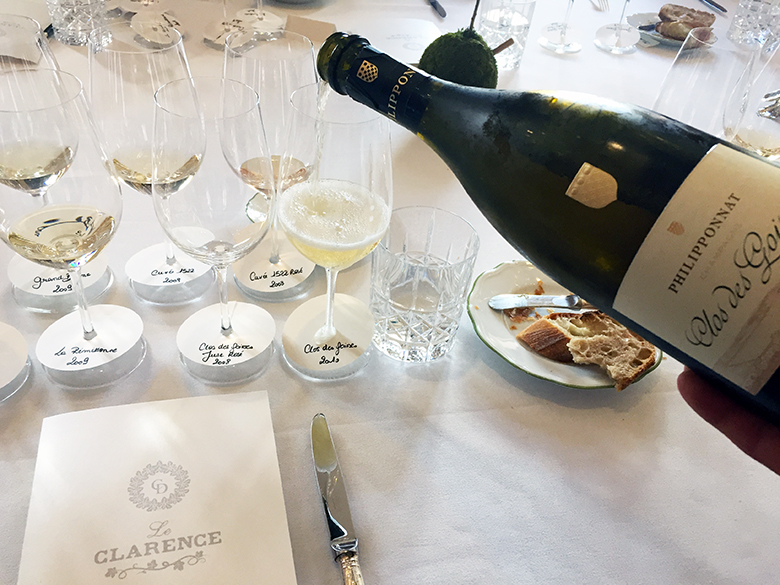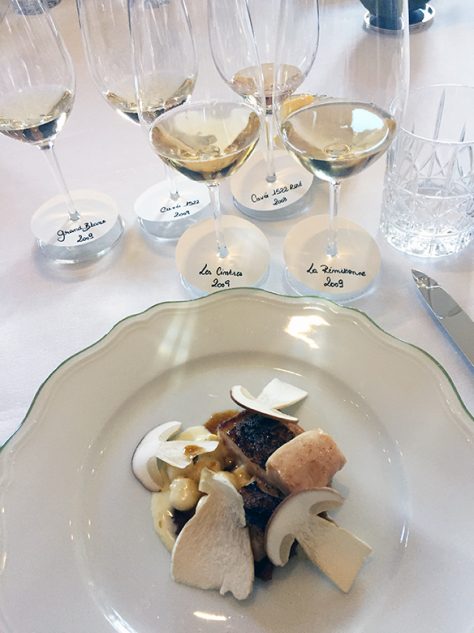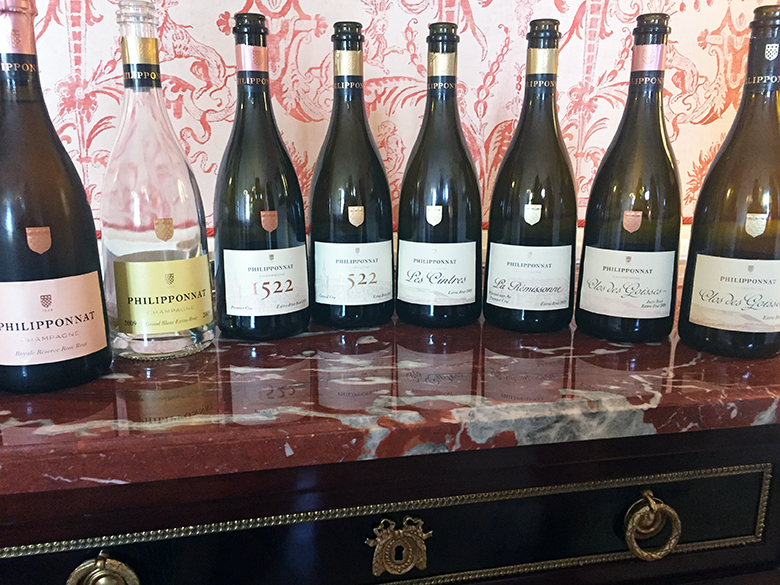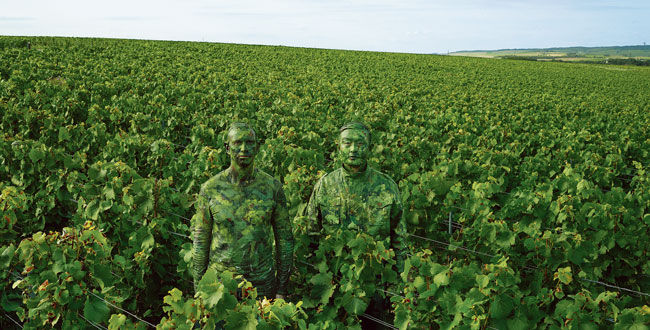
Elegance, excellence, grace. True to these principles, Charles Philipponnat invited us to discover his most recent vintages. An account of this exceptional tasting.
The Philipponnat house, a family estate since the 16th century, has now joined the ranks of the Boizel Chanoine Champagne group. Charles Philipponnat continues to embody, with stringency and passion, this estate renowned for the precision and elegance of its Champagnes.
This modest and meticulous man (unmatched in the care he takes to describe each of his cuvées) leaves nothing to chance. He had therefore chosen a faultless location in which to present the fruit of his latest vintages. Le Clarence, Paris, is an exquisite place, renovated from top to bottom by the Prince of Luxembourg, owner of Château Haut-Brion. At this discreet and refined site, the manager Christophe Pelé conducted a carefully orchestrated arrangement that laid the ground for a cultivated selection.
Over the years, refining their knowledge and their understanding of the terroir, the Philipponnat estate has sought to develop single-varietal cuvées, whose strong point is their great rarity. Some of them are only produced in their thousands: even Romanée-Conti is more plentiful! But that isn’t the whole story, since even if Charles Philipponnat wishes to express the specificities of certain terroirs in his cuvées, he is still concerned with preserving the quality of his first cuvée. Whilst the result of one grape picking is used to make a single-varietal wine, 90% of the harvest is put into the main cuvée. So, in a way, the smaller ones serve as experimental projects.
As for the 2019 vintage, contrary to what you might think, the Champagne region didn’t really experience a heatwave. There were perhaps only three days of high heat. The summer was sunny, but it was especially the end of the season that turned out to be exceptional, and perfectly dry throughout the harvest. A true gift for the winemaker. A particularly ripe vintage – the malolactic fermentation had to be cut short – with levels of acidity much like those seen in the lovely 2008 vintage: the 2019 reveals a beautiful balance, rich in aromas but not oxidative since the harvest was largely homogenous among the different grape varieties. However, the kick in the teeth was in terms of quantity. The frost during spring and episodes of hail, without forgetting the mildew, did their worst.

Cuvée 1522 – Rosé 2008
This cuvée marks the origins of the family estate in Champagne, since the Philipponnat family indeed set themselves up there in 1522. A significant amount (40%) of the grape supply comes from a 2.5-hectare plot at Aÿ, near to the Jacquesson vines. This grand cru’s steep terroir is made up of clay soil. The red wine used in the blend comes from vines planted on the highest terrace of Clos de Goisses, no less. The 1522 cuvée is especially rare, with 4500 bottles being produced, and not even every year. This wine is made of 60% Pinot Noir, and its pretty appearance has a salmon-pink hue. Its subtle, fresh nose exudes aromas of wonderfully sweet citrus. To taste, its fizziness has exquisite finesse. It is largely vinified in wood without malolactic fermentation, and this is lightly perceptible but perfectly integrated into its round vinosity, where we find lingering citrus notes, offering a discreetly spiced finish.
Cuvée 1522 – 2009
It offers a nose that is pleasantly spiced and floral, and its flavours are complemented by notes of dried fruit with make a marvellous pairing with the zesty orange sauce that livens up a scallop dish. A precise Champagne with stunning freshness.
Clos des Goisses – 2010
Clos des Goisses is the house’s emblematic cuvée. This 5.5-hectare vineyard, planted in chalky soil in Mareuil sur Aÿ, was acquired by the Philipponnat family in 1935. It is not only surrounded by walls, but it also benefits from an exposure to the south strengthened by the incline that can reach up to 45% in some plots, all of which ensures perfectly mature grapes. This maturity is further amplified by the underground chalk which absorbs and preserves the heat. The making of this cuvée is a true lesson in style! By the way, the word ‘Gois’ (Goisse in the feminine) means ‘hard work’ in the patois of the Champagne region. It all begins in the vines, planted with two thirds Pinot Noir and a third Chardonnay, and continues in the vinification process. In order to preserve the cuvée’s freshness, le Clos des Goisses doesn’t undergo malolactic fermentation.
To taste, the 2010 marries perfectly the characteristics of the two grape varieties (71% Pinot Noir and 29% Chardonnay), bringing together delicately toasted aromas and floral notes, which make way for an intensely vinous palate, fully developed, ample and lively with its aromas of exotic fruit. It lingers remarkably and has a dense, concentrated finish.
Grand Blanc – 2009
This cuvée is atypical within the world of Philipponnat where Pinot Noir is honoured. However, this blanc des blancs extra brut, from Chardonnay picked on the Côte des Blancs (only premier and grand cru) is a little gem with a fine and elegant fizz, a velvety texture and flavourful body. The generous finish is salty, making this wine a superb accompaniment for crustaceans and scallops.
Charles Philipponnat also took this opportunity to offer us the jewels of the house to try, the famous – and microscopic – single-varietal cuvées.
La Rémissonne – 2009
This 100% Pinot Noir micro-cuvée – 2590 bottles produced in 2009! – comes from a plot adjacent to Clos de Goisses, composed of deep, clay soils. It offers an intense expression of this grape variety in a vinous and elegant ensemble, embellished with pleasant honey notes. The finish is immense.
Les Cintres – 2009
A pure Pinot Noir from grapes picked at the heart of Clos des Goisses. The exception within the exception, which despite a particularly sunny vintage has managed to retain a remarkable freshness (without malolactic fermentation). It has a fresh grape nose that is immediately lifted by a bouquet of spices and pepper, making room for a palate that is ample and fresh, bringing together pleasant notes of white flowers and ripe fruit. The expressive finish offers pleasant grilled notes.
See all of the Philipponnat wines available at iDealwine
See our selection of Champagne




